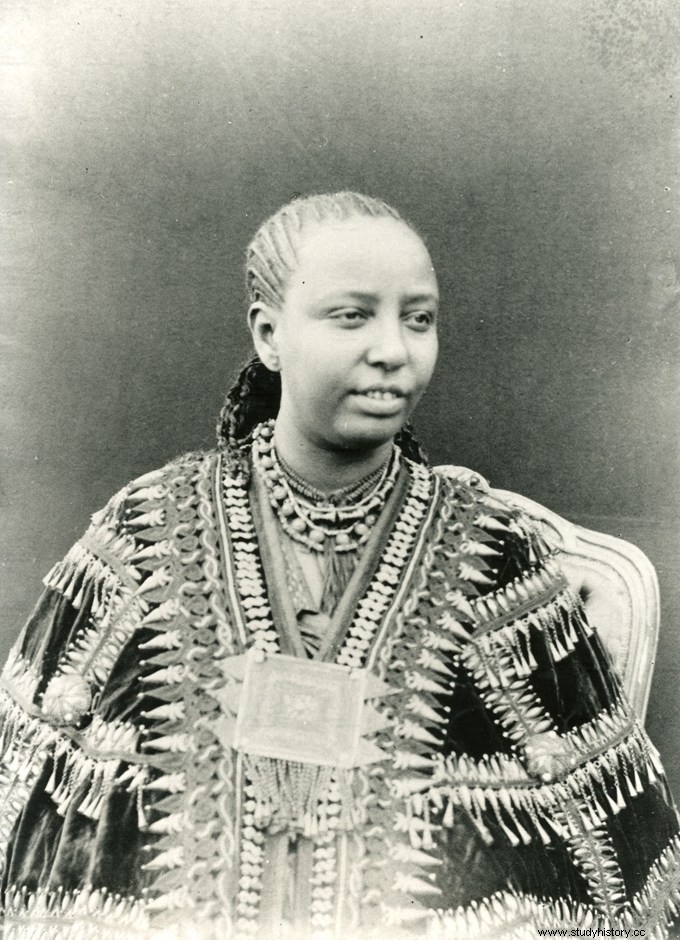Taytu Betul (ca. 1851 – 1918) was a ruler of the Ethiopian Empire – or Abyssinia – and the founder of the city of Addis Ababa. Wife of a Negus - or king -, she reigns by his side.
The wife of the Negus
 Daughter of Weyzero Yewobdar, from an Ethiopian noble family, and Ras Bitul Hayle Mariam, from an Ethiopian leader of the province of Semien, Taytu Betul was born around 1851 within the Ethiopian Empire. His family is linked to the Solomonic dynasty (claiming King Solomon and the Queen of Sheba). Taytu is the third of four children.
Daughter of Weyzero Yewobdar, from an Ethiopian noble family, and Ras Bitul Hayle Mariam, from an Ethiopian leader of the province of Semien, Taytu Betul was born around 1851 within the Ethiopian Empire. His family is linked to the Solomonic dynasty (claiming King Solomon and the Queen of Sheba). Taytu is the third of four children.
Taytu Betul married four times before meeting Sahle Maryam, Negus (king) of Shewa (historic province located in the center of the Ethiopian Empire) and better known as Menelik II. They married in 1883, during Easter week. Exercising real political power, it is opposed in particular to the current which wishes to develop Abyssinia on the model of Western countries. Suspicious of their intentions, she frequently opposes the Europeans.
Renowned for her authoritarian character and her great determination, Taytu made herself unpopular at court unlike her husband. In 1886, charmed by the landscape in the region of the future Addis Ababa, Taytu asked her husband to build the imperial residence there. It is the first building of the future capital of Ethiopia, whose name, meaning "the new flower" is chosen by the queen. In 1889, the Emperor of Abyssinia died and, supported by the Ethiopian nobility, Menelik II succeeded him. Taytu and her husband become Empress and Emperor (Negus Negest, "King of Kings") of Abyssinia.
In a period of colonization of Africa by the European powers, the Horn of Africa aroused covetousness. Established in East Africa since 1869, the Kingdom of Italy conquered Eritrea in 1890 and decided to invade Ethiopia in 1895. Taytu and her husband participated in person in the decisive battle of Adoua which saw, in March 1896, the Ethiopian victory and the end of the First Italo-Ethiopian War. She leads men and nurses there to help the wounded.
The fall of power
Three strokes, in 1906, 1908 and 1909, left Menelik paralyzed and almost unable to speak. Taytu Betul is even more involved in decision-making and closely follows the succession of her husband. Wishing to bring power back to Gonder, the region from which she originated, Taytu endeavors to have her husband's will modified to make her daughter-in-law Zewditou his heiress; but her attempts are countered by the Council of Ministers, which removes her from power and confines her to the care of her husband. In March 1910, power officially passed into the hands of the heir Iyassou and his regent Ras-Bitwoded Tessema Nadew. On the death of Menelik II in 1913, Taytu was banished and forced to retire to the former imperial palace at Entoto, near Addis Ababa.
In 1916, the new sovereign was overthrown by a coup which saw the coming to power of Zewditou. The former empress may have played a role in this takeover. The new negiste negest allegedly offered her mother-in-law to move in with her, but Taytu allegedly refused. In 1917, she asked permission to end her days in Gonder, in her native region, but this request was refused.
Taytu Betul died on February 11, 1918. She rests in a mausoleum in the Menelik Palace in Addis Ababa, alongside her husband.
